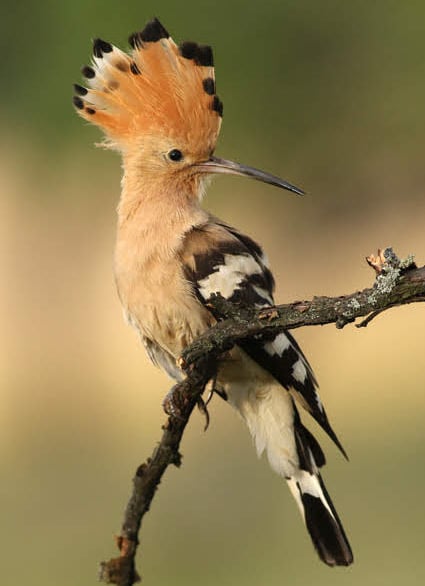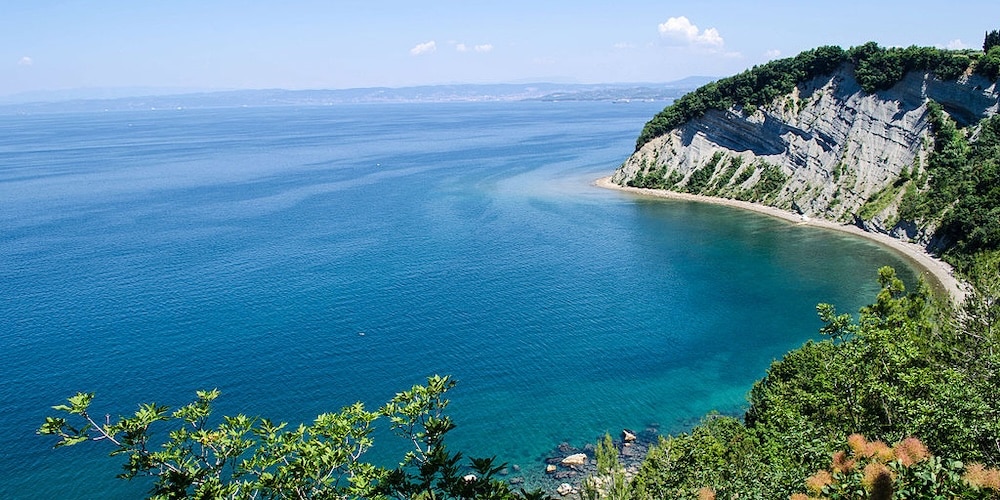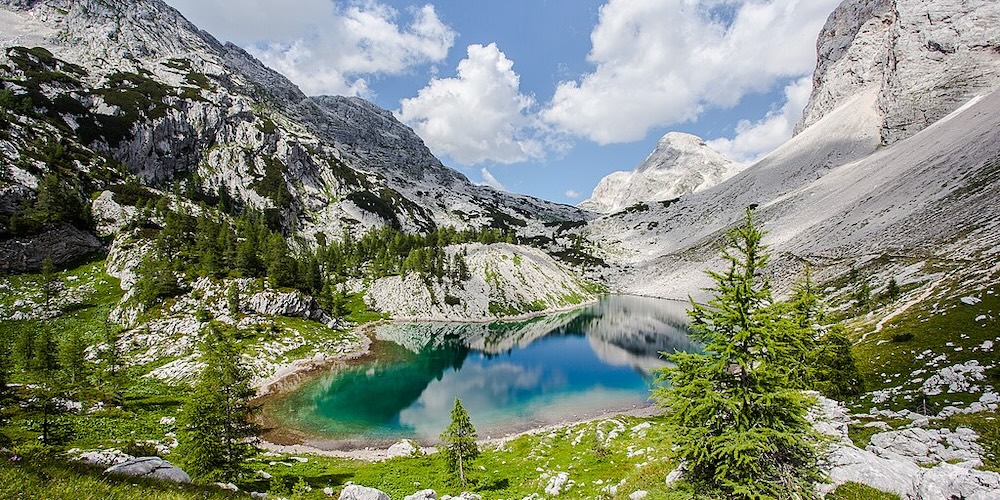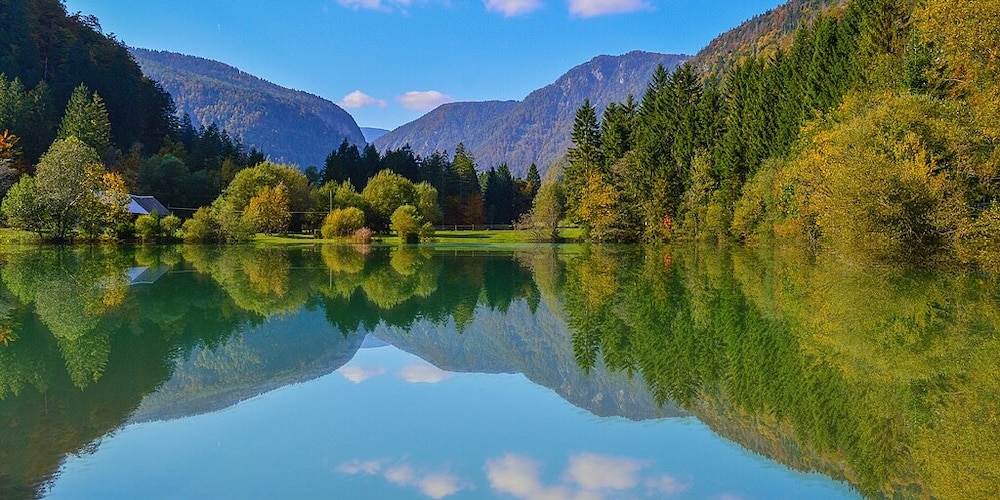Republic of Slovenia

Slovenia is a country in Central Europe between the alps and the Mediterranean Sea. It borders Italy to the west, Austria to the north, Hungary to the northeast, Croatia to the south and southeast, and a short coastline within the Adriatic Sea to the southwest. Slovenia is mostly mountainous and forested, covers 20,271 km2 (7,827 square miles) and has a population of over 2.1 million people. Slovene is the official language. The country has a predominantly temperate continental climate, with the exception of the Slovene Littoral and the Julian Alps. Ljubljana, the capital and largest city with around 300,000 people, is geographically situated near the centre of the country. Other larger urban centres are Maribor, Ptuj, Kranj, Celje and Koper.
Four major European geographic regions meet in Slovenia: the Alps, the Dinarides, the Pannonian Plain, and the Mediterranean Sea. Although on the shore of the Adriatic Sea near the Mediterranean Sea, most of Slovenia is in the Black Sea drainage basin. The Alps, including the Julian Alps, the Kamnik-Savinja Alps and the Karawank chain, as well as the Pohorje massif dominate Northern Slovenia along its long border with Austria. Slovenia’s Adriatic coastline stretches approximately 47 kilometres (29 miles) from Italy to Croatia.

Strunjan Bay – ©Rok CC BY-SA 2.0 via Wikimedia Commons
Slovenia’s Karst Plateau is a limestone region of underground rivers, gorges, and caves, between Ljubljana and the Mediterranean Sea. On the Pannonian plain to the East and Northeast, toward the Croatian and Hungarian borders, the landscape is essentially flat. However, most of Slovenia is hilly or mountainous, with around 90% of its land surface over 650 feet. The central rivers are the Mura River basin, the Drava River basin, the Sava River basin with Kolpa River basin, and the basin of the Adriatic rivers.
More than half of Slovenia is forested; ranking it third in Europe, by percentage of area forested, after Finland and Sweden. The areas are covered mostly by beech, fir-beech and beech-oak forests. Remnants of primeval forests are still to be found, the largest in the Kočevje area. Grassland covers 5,593 km2 (2,159 square miles) and fields and gardens (954 km2). There are 363 km2 of orchards and 216 km2 of vineyards.
Slovenia is influenced by the variety of relief, and the influence of the Alps and the Adriatic Sea. In the northeast, the continental climate type with the greatest difference between winter and summer temperatures prevails. In the coastal region, there is a sub-Mediterranean climate.

Mur River Oxbow – ©Miggie H, CC BY-SA 3.0 via Wikimedia Commons
The effect of the sea on the temperature rates is also visible up the Soča Valley, while a severe Alpine climate is present in the high mountain regions. There is a strong interaction between these three climatic systems across most of the country. Precipitation, often coming from the Gulf of Genoa, varies across the country as well, with over 138 inches in some western regions and dropping down to 31 inches in Prekmurje. Snow is quite frequent in winter. Compared to Western Europe, Slovenia is not very windy, because it lies in the slipstream of the Alps. The average wind speeds are lower than in the plains of the nearby countries.
Birding Slovenia
Protected areas of Slovenia include national parks, regional parks, and nature parks, the largest of which is Triglav National Park. There are 286 Natura 2000 designated protected areas, which include 36% of the country’s land area, the largest percentage among European Union states. The country is home to four terrestrial eco-regions: Dinaric Mountains mixed forests, Pannonian mixed forests, Alps conifer and mixed forests, and Illyrian deciduous forests.
There are 75 mammal species, among them marmots, Alpine ibex, and chamois. There are numerous deer, roe deer, boar, and hares. The edible dormouse is often found in the Slovenian beech forests. Trapping these animals is a long tradition and is considered a part of the Slovenian national identity. Some important carnivores include the Eurasian lynx, European wild cats and European jackal. According to recent estimates, Slovenia has c. 40–60 wolves and about 450 brown bears. Slovenia is home to an exceptionally diverse number of cave species, with a few tens of endemic species. Among the cave vertebrates, the only known one is the olm, a type of salamander living in Karst, Lower Carniola, and White Carniola.

Ledvica Lake in the Triglav National Park – ©Aleš Zdešar CC BY-SA 4.0 via Wikimedia Commons
Despite its small size, Slovenia has a very diverse landscape and climate, which together contribute to the relatively high numbers of breeding birds. In total, over 400 bird species have been recorded in Slovenia. Over 200 species are breeding. This remarkably high number is due to Slovenia’s position within the Western Palearctic, in the confluence zone for eastern, southern and northern faunal elements. Moreover, many species reach their northern, southern, western or eastern distributional limit here.
Wetlands important for birds in Slovenia include Secovlje Salina at the coast, the Drava and the Mura rivers, with flooded woodlands in northeastern Slovenia, Ljubljansko Barje (marshes) and Lake Cerknica in central part of the country. Some fishponds have become important sanctuaries for biodiversity in areas of modern intensive farming, especially in northeastern Slovenia. The Racki Ribniki fishponds (protected as a Landscape Park with neighbour area) and Vrbje Pond are important both for breeding as well as for migrating bird species (e.g. various ducks, herons, waders, grebes).

Racki Ribniki Fishponds – ©Eleassar CC BY-SA 3.0 via Wikimedia Commons
Other very valuable bird habitats are the Krakovski forest, forested areas in Notranjsko, in the Julian and Savinja Alps, and the Karst region. A significant number of boreo-montane type bird species, including Black Grouse Tetrao tetrix, Capercaillie Tetrao urogallus, Pygmy Owl Glaucidium passerinum, Ural Owl Strix uralenis, Tengmalm’s Owl Aegolius funereous, and Three-toed Woodpecker Picoides trydactylus are found in the Alps and in the Dinaric region. Good nesting conditions exist also for various woodpeckers and raptors (e.g. Black Woodpecker Drycopus martius, Three-toed Woodpecker Picoides trydactylus, and Golden Eagle Aquilla chrysaetus). The Dinaric region also has relatively numerous populations of some other animals, especially big mammals such as Bear, Lynx & Wolf.

Lake Kreda – ©Rok B CC0 via Wikimedia Commons
Areas of lowland meadows and non-intensively cultivated land have virtually disappeared, mostly as a result of intensive agriculture or construction of reservoirs. As a result of large-scale and intensive agriculture production, some species such as Grey Partridge Perdix perdix, Corncrake Crex crex, and Snipe Gallinago gallinago are endangered. On the other hand, some species successfully colonize intensively farmed fields. Examples include Quail Coturnix coturnix, Lapwing Vanellus vanellus, Little-ringed Plover Charadrius dubius, Skylark Alauda arvensis; Stonechat Saxicola torquata, and Yellow Wagtail Motacilla flava complex. In this region, scattered and isolated forests in agricultural areas are important refuges for small passerines.
In the traditionally extensive rural landscape, fruit or traditional orchards are also very important bird habitats. Many endangered species, mostly hole-nesting, such as Little Owl Athene noctua, Redstart Phoenicurus phoenicurus, Hoopoe Upupa epops and Wryneck Jynx torquilla are commonly found in orchards across Slovenia.
Slovenia is one of the top 10 countries within the Western Palearctic for breeding of the following species: Rock Partridge Alectoris graeca, Scops Owl Otus scops, Rock Bunting Emberiza cia, Ural Owl Strix uralensis, Rock Thrush Monticola saxatilis, Zitting Cisticola Cisticola juncidis, Firecrest Regulus ignicapillus, Alpine Chough Pyrrhocorax graculus, Snowfinch Montifringilla nivalis, & Cirl Bunting Emberiza cirlus. The first three species have restricted distribution in Slovenia; Rock Partridge Alectoris graeca and Rock Bunting Emberiza cia live almost exclusively in the western Karst and Alpine regions, whereas Scops Owl Otus scops is restricted mainly to the Karst region and the most north-eastern part of the country. It is worth mentioning that relatively high number of the globally threatened Corncrake Crex crex is also found in Slovenia.

Drava River – ©Nxr-at CC BY-SA 4.0 via Wikimedia Commons
Besides nesting, the Drava river and its reservoirs in north-eastern Slovenia are very important also for migrating and wintering species. During the wintering and migration period, the Drava and its reservoirs are the most important site for waterfowl in Slovenia. About 20,000 waterfowl (Goldeneye Bucephala clangula up to 3500, Tufted Duck Aythya fuligula up to 7000) winter there. About 100 Goosander Mergus merganser, the same number of Smew Mergus albellus, and up to 6000 Teal Anas crecca regularly winter there too. The Ormoz reservoir on the Drava near the Croatian border is an important site for roosting geese; Bean Geese Anser fabalis up to 4000, and White-fronted Geese Anser albifrons up to 1500.
During spring migration, a huge number of Black Tern Chlidonias niger (4000 – 8000) migrate along the Drava. The nearest agricultural area, Dravsko polje, is important for migrating raptors, including Osprey Pandion haliaetus and Marsh Harrier Circus aeruginosus and for wintering of Great Egret Ardea alba (up to 50 individuals).
-
Number of bird species: 404
(As at April 2025)
-
Avibase
PDF ChecklistThis checklist includes all bird species found in Slovenia , based on the best information available at this time. It is based on a wide variety of sources that I collated over many years. I am pleased to offer these checklists as a service to birdwatchers. If you find any error, please do not hesitate to report them. -
Birdlife Slovenia
Annotated ListList of birds in Slovenia – categories A, B, C, D and E -
E-Bird
PDF ChecklistThis checklist is generated with data from eBird (ebird.org), a global database of bird sightings from birders like you. If you enjoy this checklist, please consider contributing your sightings to eBird. It is 100% free to take part, and your observations will help support birders, researchers, and -
Wikipedia
Annotated ListThis is a list of the bird species recorded in Slovenia. The avifauna of Slovenia include a total of 404 species, of which four have been introduced by humans.
-
Birds of Europe, North Africa, and the Middle East
| Photographic Guide | By Frédéric Jiguet & Aurélien Audevard | PUP | 2017 | Paperback | 447 pages, 2200 colour photos, colour distribution maps | ISBN: 9780691172439 Buy this book from NHBS.com -
Birdwatching in Slovenia
| DVD | By Steve Evans | Isabelline Films | Runtime: 71 min, rating: E | All Region | ISBN: #206778 Buy this book from NHBS.com -
Collins Bird Guide
| By Lars Svensson | Harper Collins | Edition 3 | 2023 | Paperback | 478 pages, 4000+ colour illustrations, 700 colour distribution maps | ISBN: 9780008547462 Buy this book from NHBS.com

Collins Bird Guide
AndroidThe Collins Bird Guide App provides everything you need to identify a species quickly and learn about it thoroughly.
Collins Bird Guide
Apple iOS |Collins Bird Guide 4+ A field guide to Europe NatureGuides Ltd. Designed for iPadOrganisations-
DOPPS - Drustvo Za Opazovanje in Proucevanje Ptic Slovenije - (BirdLife Slovenia)
WebsiteDOPPS-Birdlife Slovenia is a non-profit, non-government organisation established in 1979. We work in the public interest of nature conservation, environmental protection and research. Our activities attract the participation of over 1000 members, volunteers and nature lovers from all across Slovenia. -
DOPPS Rarities Committee
WebpageOur aim is to collect, evaluate and analyse data on rare bird species in Slovenia. We publish reports on our work and maintain the list of birds of Slovenia. We are responsible for the credibility of published records of rare species, thus making them suitable for inclusion in further research. -
IxobryChus Ornithological Association (OAI)
WebsiteFounded in 1983, the Ornithological Association IXOBRYCHUS (OAI) is one of the oldest ornithological organization in Slovenia devoted to the scientific study of birds. Ixobrychus is primarily an NGO organisation, its membership of 100 includes many amateurs dedicated to the advancement of ornithological science.
Reserves-
*List of protected areas of Slovenia
InformationSatellite ViewInteractive listb of national & regional parks, nature reserves et6c... -
BR Mura
InformationSatellite ViewMura-Drava-Danube (UNESCO designation: Bačko Podunavlje, Serbian Cyrillic: Бачко Подунавље) is a transboundary biosphere reserve along the Drava, Mura and Danube rivers.[1] The reserve spans 631,460.71 hectares (1,560,373.4 acres), 395,860.71 hectares (978,193.1 acres) in Croatia, and 235,600 hectares (582,000 acres) in Hungary. -
NP Triglav
InformationSatellite View -
NPa & IBA Sečovlje Saltpans
InformationSatellite ViewThe Secovlje saltpans are so far the only Slovenian wetlands on the list and are famous for their exceptional ecological and landscape value… -
NR Snežnik
InformationSatellite ViewThe animals living there include brown bears, wolves, deer, wild boars, and lynx, as well as a number of bird species such as the Ural owl, corn crake, western capercaillie, hazel grouse, and golden eagle. -
NR Strunjan-Stjuža
InformationSatellite ViewThe Strunjan Nature Reserve is part of the Strunjan Nature Park and is located along a 4 km stretch of Adriatic coast between the Simon and Strunjan Bays. It is the longest section of unspoilt coastline in the entire Gulf of Trieste and represents with its land and submersed parts, a natural wonder with extremely important geo-morphologic, geologic, petro graphic, floristic and faunistic aspects. The entire area of the park amounts to around 160 hectares. -
NR Zelenci
InformationSatellite ViewZelenci, considered as being the source of the Sava Dolinka River was declared a nature reserve in 1992. It encompasses not only the emerald green lake, after which it was named, but also its surrounds, to make up a total area of 47 ha. Re-emerging water from an underground stream originating in the Planica Valley forms a 2 m deep lake. The porous chalk bottom of the lake permits a constant up-welling of groundwater in tiny jets, an occurence unique in Slovenia. -
NR Škocjanski Zatok
WebsiteSatellite ViewBecause of the rich intertwining of semi-arid and freshwater living environments, the Škocjanski zatok is a paradise for many animal and plant species, and therefore for all those who love to observe and experience nature. The area is particularly important due to the large variety of birds. In the last decade, over 122 hectares of the large protected area of the Škocjan spit have been listed by the ornithologists as many as 250 different species. -
Nature Parks in Slovenia
WebsiteSatellite ViewThe strategy of nature conservation foresees six regional parks. The Caves of -
Wetlands
InformationSatellite ViewThe convention entered into force in Slovenia on 25 June 1991. Slovenia currently has 3 sites designated as Wetlands of International Importance (Ramsar Sites), with a surface area of 8,205 hectares.
Sightings, News & Forums-
eBird
SightingseBirding This Month
Guides & Tour Operators-
FEATURED
Birding Slovenia
Local Tour Operatorwe (Birding Slovenia) have a new offer for wildlife travelers - custom guided birding tours in Slovenia. Other similar entities providing that kind of service in Slovenia stopped working or do that very occasionally now. -
Ecotours
Tour Operator -
FotoNatur
Local Tour OperatorWe have possibilities for variety of different birding tours all year round. -
GreenTours
Tour OperatorSlovenia and Croatia has suffered less from habitat destruction than most of Central Europe and these habitats in European terms are extremely biodiverse. -
NatureTrek
Tour OperatorAn exciting 6-day holiday to Slovenia, focusing on its Brown Bears, birdlife and other natural history highlights and including a visit to the fascinating Križna Jama cave system. -
Rockjumper
Tour OperatorCroatia, Slovenia & Austria - Bird Photography Tour -
SakerTour
Tour OperatorNow we offer you the possible combination of this GT with our revised Danube Delta and Dobrudja Spring Tour or with the Austria, Slovenia and Croatia Spring Tour. -
The Travelling Naturalist
Tour OperatorSlovenia offers a fantastic variety of bird species from the mountain lakes and meadows of the Alps to the sandy dunes that roll into the Mediterranean -
WildSlovenia
Local Tour OperatorExplore the Dinaric forests of southern Slovenia in search of territorial woodpeckers and forest owls and visit scenic limestone cliffs to observe the colourful Wallcreeper. Enjoy breathtaking scenaries in the heart of the Julian Alps. An incredible biodiversity awaits you here: from high-alpine mammals such as Alpine Ibex and Marmot to carpets of colourful endemic flowers, rare birds like Ptarmigan and Snowfinch and a vast selection of rare butterflies.
Trip Reports-
2016 [03 March] - Paul Tout
PDF ReportThis holiday, as for every Honeyguide holiday, also puts something into conservation in our host country by way of a contribution to the wildlife that we enjoyed. The conservation contribution of £40 per person was supplemented by Gift Aid and we were able to give £250 to DOPPS (BirdLife Slovenia). As at the end of March 2016, the total for all conservation contributions through Honeyguide since 1991 was £105,338. -
2016 [07 July] - Slovenia & Croatia
PDF ReportA group of 10 from a UK based Natural History Society spent a really enjoyable time, courtesy of Ecotours Wildlife Holidays, in three centres across Slovenia and Croatia. We had a diverse range of interests across the group which was our reason for choosing this particular tour. We wanted more than just the fabulous birds to be seen in the region. -
2019 [05 May] - Naturetrek
PDF Report...We saw or heard Raven, Serin, Chaffinch, Blackcap, Nightingale, Greenfinch, Marsh Tit and Wryneck as we skirted the perimeter of the grounds and the forest bordering the River Mirna. Wryneck in particular seem particularly common around the hotel this year with several pairs but Lesser Spotted Woodpecker were inexplicably scarce throughout the week... -
2019 [06 June] - Naturetrek
PDF Report...One bird seen soaring was initially identified as a Black Stork but eventually proved to be a Great Cormorant, the only one seen during the week. Songbirds seen including the usual Skylarks, Whinchats, Tree Pipits, Marsh Warblers and Yellow Wagtails...
Other Links-
Birdlife in Slovenia
WebsiteWetlands important for birds in Slovenia include Secovlje salina at the coast, the Drava and the Mura rivers, with flooded woodlands in northeastern Slovenia, Ljubljansko barje (marshes) and Lake Cerknica in central part of the country. Some fishponds have become important sanctuaries for biodiversity in areas of modern intensive farming, especially in northeastern Slovenia. The Racki ribniki fishponds (protected as a Landscape Park with neighbour area) and Vrbje pond are important both for breeding as well as for migrating bird species (e.g. various ducks, herons, waders, grebes).
Fatbirder - linking birders worldwide...
Skip to content
